#walsingham/elizabeth
Explore tagged Tumblr posts
Text

I was trying to redraw a scene from Elizabeth I (2005) but I think I went overboard
#art#digital art#artists on tumblr#my art#Elizabethan Era#Elizabeth i#Francis Walsingham#William Cecil#Lord Burghley#Robert Cecil#Earl of Salisbury#digital painting#digital illustration#fanart
30 notes
·
View notes
Text
just a comparison
Mayor Francis in 1998





Sir Francis in 2007





I like it so much that in the first part he is a cunning, reasonable and cold person, and the second is a wise, tired old man
#elizabeth 1998#elizabeth the golden age 2007#sir francis walsingham#kate blanchett#movie#i love him#Geoffrey Rush#geoffrey rush
17 notes
·
View notes
Text

h a p p y b i r t h d a y
Geoffrey Rush AC
6 July 1951
🎈🎈🎈
[pic: rush as sir francis walsingham, elizabeth, 1998]
#happy birthday#actor#geoffrey rush#born on this day#film#Elizabeth#Elizabeth film#elizabeth 1998#Shekhar Kapurr#character#Sir Francis Walsingham
9 notes
·
View notes
Text
Can we all agree that the main villain of Mary Queen of Scots's demise and failed reign is not Elizabeth I or Cecil or Walsingham or anyone at the English court?
It's actually Lord D*rnley. *Mic drop*
#i said what i said#he's a piece of shit#disgusting idiot#HATE HIM#filled with rage#this is the same dude who had her friend killed in front of her whilst she was pregnant#stuartposting#stuarts#tudors#elizabeth i#william cecil#sir francis walsingham#mary queen of scots#not even tagging the other one#we have a pretty witty queue
8 notes
·
View notes
Text

"God is my witness that as a private person I have done nothing unworthy of an honest man, and as Secretary of State, nothing unbefitting my duty."
francis walsingham during the october 1586 trial of mary, queen of scots
#🌊#sir francis walsingham#historical quotes#tudor history#elizabethan era#francis walsingham#history#i'm fully obsessed with him and robert devereux now.... save me!#tagging this with six idiots stuff because i couldnt resist putting a pic of larry in this.... sorry#bill 2015#laurence rickard#elizabeth i#geoffrey rush#mary queen of scots
11 notes
·
View notes
Text
ON THIS DAY - 14 October 1586
On This Day (14 Oct) in 1586, the trial of Mary, Queen of Scots began at Fotheringhay Castle, Northamptonshire: she had been charged with plotting the assassination of Elizabeth I.

Mary had been arrested on 11 Aug 1586 whilst being held prisoner at Chartley Manor, Staffordshire; she had been held there since Dec 1585, the residence of Robert Devereux, 2nd Earl of Essex. From here she was transported to nearby Tixall House, before finally being moved to Fotheringhay on 25 Sep 1586.

It was whilst at Chartley that Mary corresponded with Anthony Babington, a Catholic and long-time supporter of hers; letters were written in cypher and transported in and out of the house in beer barrels. Babington was the head of the eponymous 'Babington Plot' - a conspiracy to assassinate Elizabeth and place the Catholic Mary on the English throne. However, Elizabeth's Secretary of State and 'spymaster' Sir Francis Walsingham was able to intercept these letters, leading the arrest of Babington, his co-conspirators and eventually Mary. It was these letters that were used as evidence against Mary, and led to her being tried on charges of high treason.

Mary's trial was held in the Great Hall at Fotheringhay - an 'examination' of the evidence by a panel of English nobles, under the 'Act of Association'. Being found guilty under this act would lead to Mary being stripped of her claim to the English throne, and lawfully being put to death. She appeared in person at 9 o'clock in the morning, in front of crown representatives and noblemen, including William Cecil, Baron Burghley (Elizabeth's Lord High Treasurer) Walsingham and George Talbot, 6th Earl of Shrewsbury, under whose custody she had been held for 15 years. She wore her favoured garments of her captive years: a black velvet dress and mantle, with white headdress (with widows peak) and veil.

Mary denied the charges put to her, as well as arguing that she had been denied access to legal counsel. She continued to assert her authority as an anointed queen, and expected to be treated so. Correspondence between the two were passed around, in addition to Babington's deposition and signed confessions of two co-conspirators; Mary denied ever having met Anthony Babington, and accused Walsingham of inventing the cyphers and manufacturing the plot to implicate her. However, she confirmed that she continued to support Catholic interests in England, as well as abroad.

Elizabeth had ordered that no sentence be passed until all the evidence had been presented to herself, and following the conclusion of the trial on 15 Oct, the panel returned to London. Their findings were subsequently presented to Elizabeth on 25 Oct 1586 at the Star Chamber in London; Mary was found guilty of being "not only accessory and privy to the conspiracy, but also an imaginer and compass of her majesty's destruction" and a sentence of death was passed. However, Elizabeth continued to demonstrate ambiguity, requesting attempts to obtain a 'full confession' from the Scottish Queen, in an attempt to save her life, and void any retaliatory action from Mary's Catholic allies abroad.

#tudor#tudors#tudor women#tudor queens#tudor england#tudor history#history#England history#tudor people#Elizabeth i#Mary queen of scots#francis walsingham#Anthony babington#Babington plot#George talbot#bess of hardwick#Charley manor#Framlingham castle
2 notes
·
View notes
Text
What then was Hatton’s position within the small group of men who formed Elizabeth’s key policy advisors? The current orthodoxy, as we have seen, is that the leading ministers of the 1570s and 1580s were largely united in pursuing the same goals, in particular the promotion of Protestantism. Superficially, this is fair: they clearly did work together with little obvious animosity for long periods. Yet if, as this book argues, Hatton’s attitudes, in religion at least, differed significantly from his colleagues, did this lead to dissent or acrimony between them, as comparable situations did in the 1560s or the 1590s? Were their relations genuinely amicable, or merely politely cautious? In general, there is very little evidence of active hostility, something helped both by Hatton’s genial personality and by ministers’ awareness that the Queen disliked discord. Hatton participated in the solidarity among senior ministers which marked mid-Elizabethan politics. He did many favours for them. His early encounters with Burghley, for example, were very respectful, with each taking advantage of the other’s influence with the Queen and the administrative machinery, respectively. They continued to exchange cordial letters, discussing policy and building projects and wearily complaining about the burdens of office and ‘our troblesome courtinge life’, as Hatton once put it. There are similar signs of regard with Leicester. Hatton gave Leicester two fine suits of armour, one of which Leicester left back to him. Leicester also made Hatton an overseer of his will, and left him ‘one of my greatest basons and ewers gilte with my best George and garter not doubting but he shall shortly enjoye the wearing of it and one of his Armors he gave me’. Quite likely Leicester hoped that Hatton would help to protect his widow, whom the Queen notoriously loathed. More persuasive are several very cordial, sympathetic letters between them. Hatton wrote a genuinely sympathetic and poignant letter of comfort on the death of Leicester’s son, Lord Denbigh, in 1584.
Neil Younger, Religion and politics in Elizabethan England: The life of Sir Christopher Hatton
#Neil Younger#non-fiction#Christopher Hatton#William Cecil#Robert Dudley#Elizabeth's council#but I must warn you this book highlights not cooperation and cordiality but disagreements between them#it's Hatton vs trio Burghley Leicester and Walsingham in this book
2 notes
·
View notes
Text

Just so you all understand the depths of my procrastination/executive dysfunction/whatever... This WIP is over 2 years old. Thought I'd add a bit more today. Maybe I'll finish it before I die.
This is a sketch for an insane AU of an Elizabeth (1998) movie fanfic which was already an insane AU and tbh the fanfic took me something like 12 years to come back to and complete so I just don't do well with this long suffering OTP of mine... But I still love them.
#walsibeth#elizabeth 1998#elizabeth 1998 fanfic#alternate universe of an alternate universe#elizabeth i#sir francis walsingham#geoffrey rush#cate blanchett#elizabeth 1998 fanart#otp
6 notes
·
View notes
Text
The Amazing Readathon Week Two
The Amazing Readathon is a readathon created by Brianna from Four Paws and a Book and co-hosted by many others in the BookTube and Bookstagram community. This one is based on the reality TV show The Amazing Race and it’s about spending the month of August travelling the world. There are prompts and ways you can get bonus points (team colour, BIPOC author, etc.). It turns out that we’re not…

View On WordPress
#Agatha Christie#Biography#Books#Eleanor Shearer#Elizabeth Chadwick#England#English History#Francis Walsingham#Henry I#Historical Fiction#Historical Thriller#History#King Stephen#Margaret Owen#Medieval#Mystery#Nancy Goldstone#Queen Matilda#The Amazing Readathon#Thriller
0 notes
Text
Publication of ‘Elizabethan Rebellions: Conspiracy, Intrigue and Treason’!
I’m absolutely delighted to be able to announce that my debut book ‘Elizabethan Rebellions: Conspiracy, Intrigue and Treason’ is available to order in the UK RIGHT NOW. You can order it direct from Pen and Sword here. If you have pre-ordered it from somewhere like Amazon, Waterstones, or Foyles, I’m afraid you’ll have to wait until the official release date of 30 January. But if you’ve been…

View On WordPress
#author#Babington Plot#Book#conspiracy#Elizabeth I#elizabethan rebellions#essex rebellion#Francis Walsingham#History#Mary Queen of Scots#northern rising#parry plot#Pen and Sword#plot#Rebellion#Rebellions#research#Revolt#Ridolfi Plot#Throckmorton Plot#Treason#Tudor#Tudors#writer#Writing
1 note
·
View note
Text
This remark so often misquoted and so often attributed to Elizabeth herself is to be found in The Works of Francis Bacon, ed. James Spedding, Robert Leslie Ellis and Douglas Denon Heath (14 vols, London, 1857–74): Lord Bacon’s Letters and Life, vol. 1, p. 178. It occurs in Bacon’s ‘Observations on a Libel’ of 1592, but is also to be found word for word with its surrounding material in a letter of Francis Walsingham to M. de Critoy, written between 1589 and Walsingham’s death in 1590: ibid., p. 98. Spedding is almost certainly correct in postulating that Bacon had ghost-written this letter of Walsingham’s.
Diarmaid Macculloch, All Things Made New
The queen’s remark, reported by Francis Bacon, that she did not seek to make windows into men’s hearts, is often misquoted as referring to men’s souls, and I wonder whether the difference is significant. The heart is not the seat of salvation as is the soul. It would not be inconsistent with Protestantism for the queen to care less about feelings or opinions than about salvation
Diarmaid Macculloch, All Things Made New
26 notes
·
View notes
Text
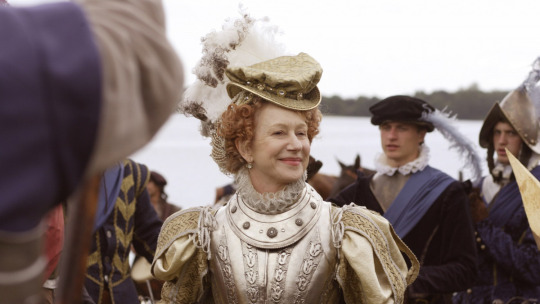
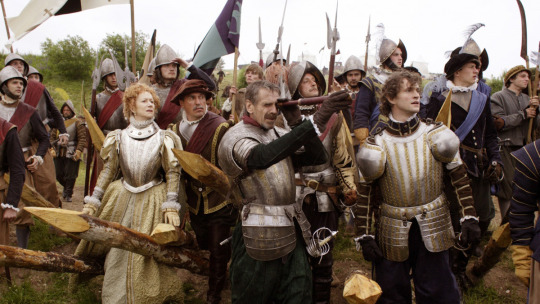
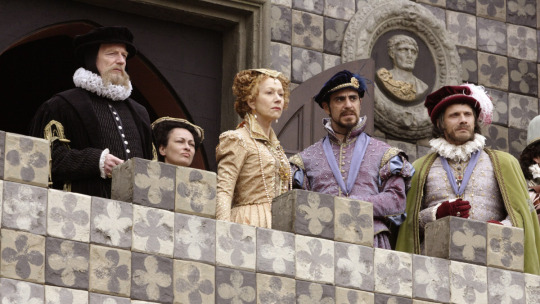
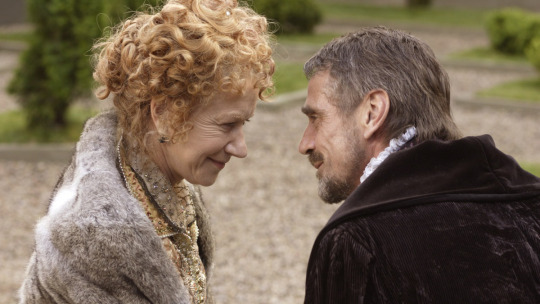

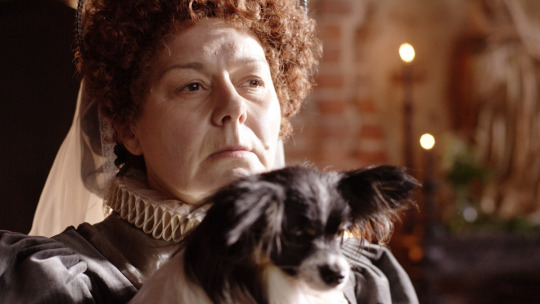
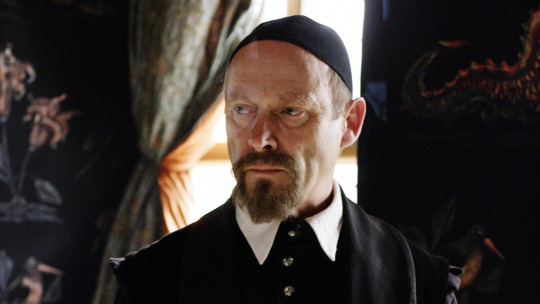



e l i z a b e t h i, 2005 📺 dir. tom hooper
#miniseries#hbo#Elizabeth i#elizabeth i 2005#tom hooper#helen mirren#jeremy irons#hugh dancy#Patrick Malahide#ian mcdiarmid#Barbara Flynn#Queen Elizabeth I#Earl of Leicester#Earl of Essex#Sir Francis Walsingham#Lord Burghley#Mary Queen of Scots
19 notes
·
View notes
Text
Intelligence agencies 101: MI6
Dashing spies and deadly agents, from James Bond to Alex Rider and George Smiley. We have all heard of British Intelligence, but just how much do you know about MI6?

1.- It is the oldest secret service in the world.
If we want to get technical, spies have been working for the British crown since 1569, thanks to Queen Elizabeth I and her Secretary of State, Sir Francis Walsingham. But for now, we'll focus on the contemporary Secret Service.
Hear me out, back in 1909 in the midst of what we call the "armed peace", things were getting anything but peaceful. Countries developed and accumulated weapons like it was a sport, and most of them were unsatisfied with the territories they owned. Germany was going all Queen and screaming "I Want It All", which made the rest of the European countries slightly concerned by its imperialistic ambitions.
Britain was the first to grow paranoid and so Prime Minister Asquith decided to have the Committee of Imperial Defence, create a Secret Service Bureau.
However, it is worth mentioning that the existence of the agency wasn't formally acknowledged until 1994, under the Intelligence Services Act, and even though everyone had known about it for ages.
2.- They have very... diverse tasks
Officially, MI6 is tasked with the collection, analysis, and adequate distribution of foreign intelligence (it is a common misconception that MI6 also handles national affairs, that's what its counterpart MI5 is for).
Now, note that I said "officially", and that is because unofficially (it is kind of very illegal), MI6 has been known to carry out espionage activity overseas. But you already knew that, didn't you? Otherwise, why would you be here?
3.- Roles
As described by the SIS itself, there are several roles within the organisation:
Intelligence officers: Must be UK nationals of at least 18, with no drug use and pass a very intrusive security clearance. The jobs are divided into the following subcategories:
Operational Managers: planning and managing intelligence collection operations.
Targeters: turning information (data) into human intelligence operations.
Officers: link to Whitehall (government) as well as validating and testing intelligence.
Case Officers: managing and building relationships with agents.
Operational Data Analysts: Must be UK nationals of at least 18, with no drug use and pass a very intrusive security clearance. Tech abilities are a must. Training course lasts 2 years.
Tech Network Area: Must be UK nationals of at least 18, with no drug use and pass a very intrusive security clearance. Skills in: GoLang, gRPC, Protobuf, Kubernetes & Docker Python, Java, C#, C, C++, and React (+Redux).
Language Specialists: Must be UK nationals of at least 18, with no drug use and pass a very intrusive security clearance. Russian, Arabic and Mandarin linguists are the most solicited, followed by translators.
4.- Their alphabet is a bit jumbled up
Anyone that has ever seen or read any 007 material knows that M is the head of MI6, whether that be Judy Dench, Bernard Lee or Ralph Fiennes.
But what if I told you that the head of MI6 is actually a certain C?
Back when the Secret Service Bureau was created, a 50-year-old Royal Navy officer called Mansfield Cumming (and dubbed "C") was chosen to head the Foreign Section.
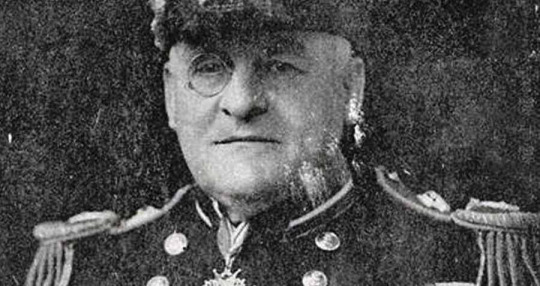
5.- MI6 or SIS?
Officially, the agency's current name (adopted in 1920) is Secret Intelligence Service, hence the acronym SIS, but it wasn't always that. We've established that it started its days as the Secret Service Bureau, and during WWI, the agency joined forces with Military Intelligence, even going as far as to adopt the cover name "MI1(c)".
The agency continued to acquire several names throughout the years, such as "Foreign Intelligence Service", "Secret Service", "Special Intelligence Service" and even "C's organisation". It wasn't until WWII started, that the name MI6 was adopted, in reference to the agency being "section six" of Military Intelligence.
And I truly do hate to be the bearer of bad news but... the name MI6, as cool as it sounds, is no longer in use. Writers and journalists still use that name, but those within the organisation just call it SIS nowadays.
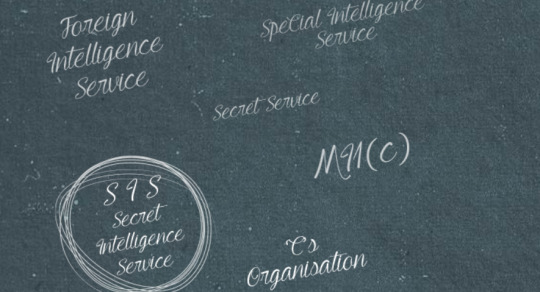
6.- They are fond of their traditions
Remember our dear Commander Mansfield? Well, turns out he started a thing. The man used to sign his letters in green ink and always with the letter "C" a tradition that proved to be sticky enough to be passed down to every single Chief afterwards. Another tradition worth mentioning, is that of calling intelligence reports "CX reports", which... you guessed it, is still done to this day.
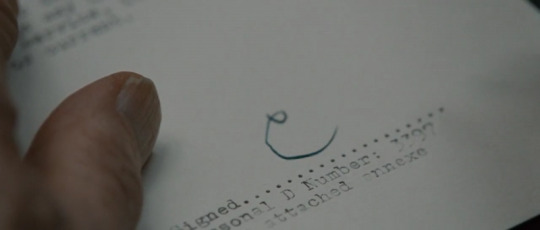
7.- Special friends
On 1949, the SIS began a formal collaboration with the CIA, even though the agency had already helped to train their predecessor's personnel, the U.S. Office of Strategic Services.
Even the CIA has admitted that the MI6 has provided them with some of the most valuable information of all time, including information that helped during the Cuban Missile Crisis and key elements to the capture of Osama Bin Laden.

I hope this will be of some use to your future writings and do feel free to submit an ask if you happen to have a specific question regarding British intelligence, or any other International Relations subject!
Yours truly,
–The Internationalist
#writing advice#writing help#writing community#writing tips#writing resources#creative writing#james bond#george smiley#alex rider#mi6#spies
443 notes
·
View notes
Text


October 14th 1586 saw the trial of Queen of Scots, begin at Fotheringhay Castle.
No matter what you think of our Scottish Queen, and whether she was guilty or not the trial was a sham and the verdict was decided long before Mary stood before them.
If you follow my posts, especially the ones that cover the Stewart’s then you will understand why Mary did not believe they had the power to try her, in her mind, and all the Stewarts before and after her, she had been anointed by god to reign. That was something holy and untouchable. There was no law in the land that could hold jurisdiction over her, the only judgement she was accountable to was God’s.
Mary was accused of plotting against Queen Elizabeth , as part of The Babington Plot, so called after Anthony Babington in one of the letters Babington wrote to Mary, he detailed plans of her rescue and asked her permission to kill the Queen. Mary’s reply agreed with the plans, but she did not authorize the assassination. When the letter passed to Walsingham, a postscript was added authorizing the assassination. Walsingham had all he needed to bring the conspiracy to light. Within days, Babington, Mary and the other conspirators were arrested.
The trial lasted two days, and Mary defended herself admirably though she had no friends or supporters present, essentially, the verdict had been decided before the proceedings had begun. She admitted her desire to escape but stated, ‘I have not procured or encouraged any hurt against Her Majesty, Queen Elizabeth.’ And she appealed for mercy, mentioning her own reputation for tolerance and kindness: ‘My subjects now complain they were never so well off as under my government.’ But she also accepted the inevitable, telling the assembled nobles, ‘May God keep me from having to do with you all again.’ When the verdict was read to her, she said, ‘I do not fear to die in a good cause.’
It would be almost four months before Elizabeth signed her death warrant, although in a letter to Mary’s son James VI, that she had been tricked into putting her signature to the document…..“…. to instruct you truly of that which is too irksome for my pen to tell you. I beseech you that as God and many more know, how innocent I am in this case : so you will believe me, that if I had bid aught I would have bid by it.”
The warrant was signed on February 1st 1587, on the night of the 7th Mary was told she was to be executed the following morning, by The Earl of Kent, when she asked to see her chaplain but he denied her this, telling her: ‘Your life would be the death of our religion, your death would be its life.’ In fact, Mary had been a tolerant ruler in Scottish religious matters. But such was the extreme religious upheaval of the time, tolerance itself was a sign of weakness.
The first pic shows a drawing of the trial of Mary, Queen of Scots from contemporary files of the day, the second a later interpretation
15 notes
·
View notes
Text
"In the 1520s, England too was a country bursting with relics. Catherine had kissed them at Canterbury, Walsingham, Westminster and St Paul’s, and followed Elizabeth of York’s example of going into labour clutching the birthing girdle of the Virgin Mary. And these relics were accessible to the people in small parish churches, not just in the large cathedrals and monasteries. In Shelford visitors might see phials of Mary’s milk and part of her churching candle, in Kaldham the finger bone of St Stephen was on display, in Burton-on-Trent pilgrims might see the staff of St Modwena, and part of the shirt of St Thomas could be found at Derby. Clothing, girdles, combs, hair, bones and bodily fluids could be found housed all around the country as an essential component of pre-Reformation Catholicism, accessible, powerful and defining. Catherine was an important religious leader in England, teaching by example. Among the artefacts that accompanied her on her travels were pictures of Mary and her mother, St Anne, and St Elizabeth, who must have had particular resonance for Catherine, as she had miraculously conceived and given birth to a child even after the onset of her menopause."
Amy Licence, Catherine of Aragon: An Intimate Life of Henry VIII's True Wife
24 notes
·
View notes
Text
Thanks to my friends who know me well for the heads-up on this! If you're interested in the real Walsingham, this is a good listen - and Geoffrey Rush gets a name drop. 🧡
#sir francis walsingham#geoffrey rush#history#tudor history#elizabeth i#elizabeth (1998)#the man the myth the legend
2 notes
·
View notes